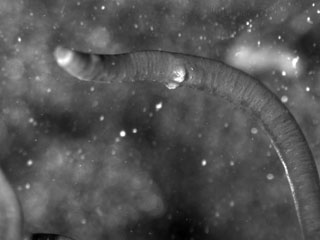Science-Technology
See other Science-Technology Articles
Title: The Ice Worm Cometh
Source:
[None]
URL Source: http://www.damninteresting.com/the-ice-worm-cometh/#more-2768
Published: Dec 22, 2011
Author: Alan Bellows
Post Date: 2011-12-22 21:25:05 by A K A Stone
Keywords: None
Views: 627
This is the prototype for our new-and-experimental Short variety of article. If well-received, these Shorts will help to fill the gaps between full articles. Please let us know what you think…who likes short Shorts? In 1887, a glacial geologist named George Frederick Wright was hiking across the Muir Glacier in southeast Alaska when something strange caught his eye. Just as the daylight began to fade, the previously uninterrupted expanse of white snow around him began to develop what appeared to be a five o’clock shadow. These wriggling “whiskers” grew rapidly and emerged from the solid ice, leaving the snow crawling with an astonishing number of small black worms. Within approximately an hour there were tens of thousands of them criss-crossing the snow as far as he could see, leaving nary a square inch unwormed. A few hours later they began to slip effortlessly back into the ice, ultimately leaving nothing but pure white snow behind for the morning sun. The ice scientist brought news of these strange ice worms back to polite civilization, yet even over a century later little is known about the intriguing organisms. The creatures that Wright observed were Mesenchytraeus solifugus–inch-or-so long ice-dwelling worms that reside exclusively in the coastal glaciers of Alaska, British Columbia, Washington, and Oregon. The ice worms are so married to their home glaciers that even when a glacier is surrounded by a snow field the creatures will not wander more than a few meters from the underlying glacier’s edge. Moreover, these unusual organisms thrive only at temperatures near the freezing point of water. If one warms an ice worm to even a few degrees above freezing the worm will melt into goo. During the coldest months of the year the worms do not appear on the surface at all; it is suspected that they creep deep into the ice and suspend their animations for the duration of winter. Although the ice worms lack eyes, some unknown mechanism allows them to respond to light and dark. By day the throngs of worms lurk as deep as two meters below the surface, and by night they squirm out to feed. Their preferred foods are bacteria, bits of pollen, and various snow algae including watermelon snow, a pinkish algae which creates swaths of snow that have the hue and aroma of fresh watermelon. Exactly how these worms penetrate the seemingly solid glacier ice is still a mystery. Some researchers hypothesize that the worms use the large pore atop their heads to excrete a lubricant that allows them to slip through minuscule fissures, while others suggest that the same pore might instead secrete an antifreeze agent that melts a path through the ice. Although ice worms are usually solitary wanderers in the friscalating dusklight, they do occasionally linger in meltwater pools during the day. There they often intermingle as writhing, knotty groups engaged in what is assumed to be reproductive ice worm orgies. In recent years NASA has provided limited funding to reverse-engineer Mesenchytraeus solifugus‘ cold tolerance to see if it might provide insight into possible life on our icy neighboring planets. More pragmatic scientists are also teasing out the ice worms’ secrets in hopes that the cold-resistant proteins might enable long-term cold-storage of human organ and tissues for transplantation. Sadly, our opportunity to exploit the ice worms is shrinking just as rapidly as the glaciers that they inhabit. Sorry ice worms. With warmest personal regards, humanity.

Post Comment Private Reply Ignore Thread
[Home] [Headlines] [Latest Articles] [Latest Comments] [Post] [Mail] [Sign-in] [Setup] [Help] [Register]
